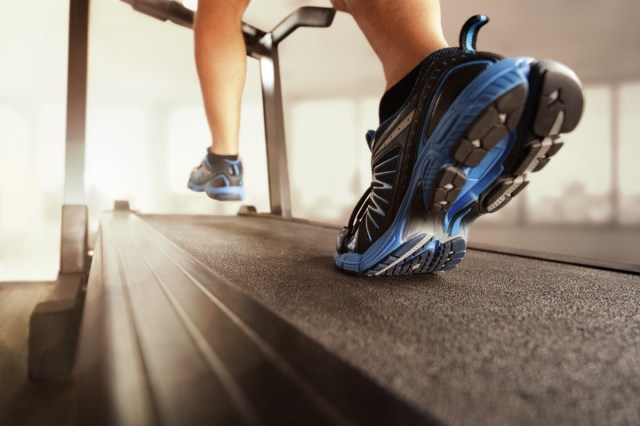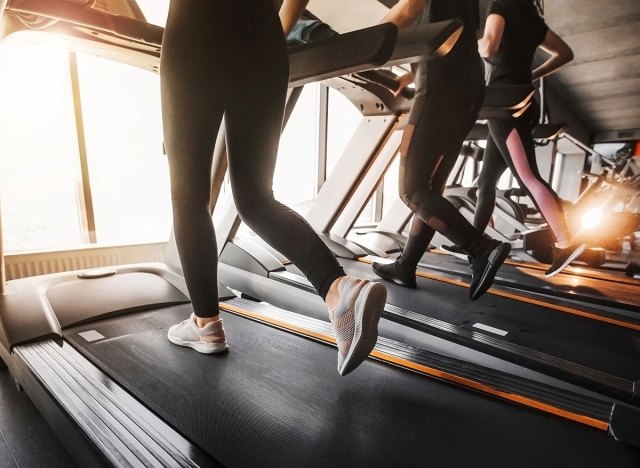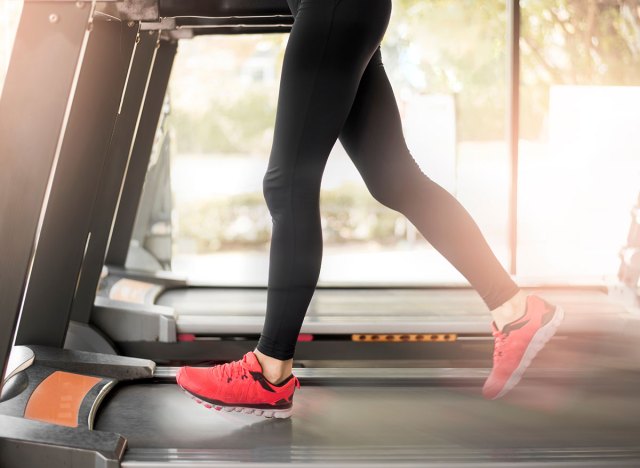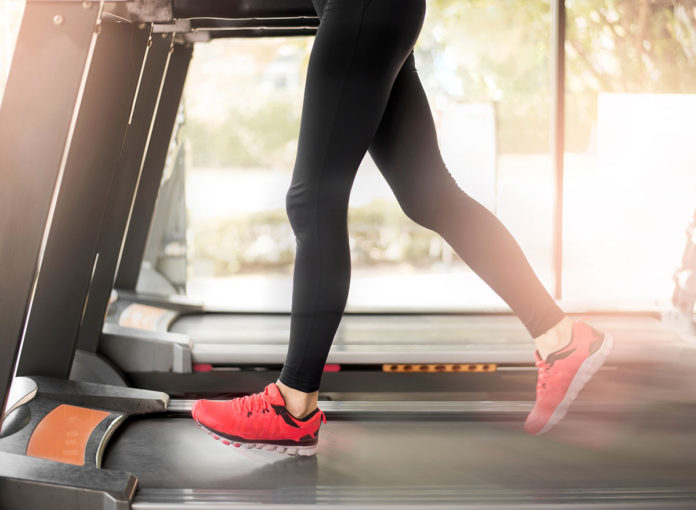Walking is the most common form of exercise in the world, and health experts agree that the best way to get the most out of your walks is to take them outside. Studies show that nature brings good vibes and a host of other great benefits, and if you’re altering the terrain of your walks, you’re all but guaranteed to work your muscles better and get a much more worthwhile workout.
So what happens when you take your walk to the treadmill at your local Crunch or in your home gym? Are you missing out on some of the wonderful benefits of walking? The short answer is yes, but that doesn’t mean that walking on a treadmill doesn’t come with its own worthwhile benefits, too.
To learn what happens to your body when you walk on a treadmill, read on, because we’ve asked scores of health and fitness experts. And for more on getting the most out of your walks, make sure you’re aware of the Major Mistakes You Shouldn’t Make While Walking, Say Health Experts.
It’s simply a fact that each step on a treadmill belt—especially if you’re not utilizing the incline function—requires less effort than it would on terra firma. “When you are on a treadmill there is much less friction than being on the ground,” says celebrity trainer Joey Thurman, CES, CPT, FNS. “As you bring your foot forward, the belt will help bring your leg back. There will be less activation by way of less resistive forces from the ground.”
This is why, for the sake of your heart and your muscles, you need to increase the incline to maximize your workout. (It’s also why This Crazy-Popular Walking Workout Totally Works, Say Health Experts.)
“Treadmill walking shows less muscle activity because there’s no wind resistance,” says David Rosales, NSCA-CPT, OTC, co-owner of Roman Fitness Systems. “It prevents your body from moving in various positions in manners because you can only go directly forward.” For more great fitness advice, make sure you know The Single Most Effective Way to Work Out Every Day, Say Psychologists.

While walking on a treadmill requires less friction, you’ll still be working on perfecting your balance. “Walking, in general, is a great exercise as you spend most of your time on one foot,” says Thurman. “Walking on a treadmill leads to better overall balance.”
If it’s indeed balanced you’re after, says John Fawkes, an NSCA-certified personal trainer and Precision-Nutrition-certified nutritional counselor, you should “switch between forward and backward walking—the latter of which will not only improve your balance but is also linked to better memory.”
RELATED: Don’t forget to sign up for our newsletter to get the latest wellness news delivered straight to your inbox!

“Walking outdoors and walking on a treadmill are both great for our bodies and minds. However, there are some significant differences,” say Joyce Shulman and Eric Cohen, the founders of 99 Walks, an app devoted to walking. “Walking outdoors presents us with unique challenges you won’t find with treadmill walking, such as uneven surfaces, varying slopes with inclines and declines, and the opportunity to climb steps or stairs. These subtle differences will engage our muscles in different ways, at different angles, and at different intervals.”
In the case of your arms, if you’re using the treadmill’s handrails and not swinging them, you’ll not only reduce your calorie burn, but you could also be affecting your posture for the worse. Remember: To maximize your walks on a treadmill, try to avoid using the handrails. Oh, and there’s one more reason you’d want to avoid the handrails…

“Many people dislike treadmills because of the feeling of dizziness after walking on the treadmill,” says Chanha Hwang, PT, DPT, CHC, a licensed physical therapist and certified health coach who runs Fatherly Health and Wellness. “If you are holding on to the treadmill for balance, the internal balance system is no longer working. As you step off the treadmill, the balance system suddenly kicks in again and you feel sudden dizziness or floating in space.”
His tip for ensuring that you don’t get motion sickness or dizziness from a treadmill? “Walk at a slower pace and take your hands off the treadmill.”

“Ultimately, the treadmill is great for cardiovascular training,” says Ollie Laver, a UK-based personal trainer and nutritionist who runs the online training site Wise Fitness Academy. Laver offers this treadmill interval workout to ensure that your heart gets pumping. Add incline to increase difficulty.
- 5-minute slow pace warm-up
- 2-minute fast past
- 1-minute slow pace
- Repeat for 20 minutes total
- 3-minute cool down at a slow pace

“Treadmills offer a few advantages,” says Rosales. “One, it’s much easier to track your progress. You have the numbers right in front of you in terms of distance, time, and incline, all of which you can adjust yourself. This ability to track progress is huge for many people. It’s easier to set goals and see how you’re improving, both of which will continue to motivate you to keep walking and build the habits.” If you’re in the market for a routine that’s a little more hardcore, consider trying This Quick 10-Minute Workout That Melts Belly Fat, Says Top Trainer.

“Walking on a treadmill works several parts of your body, including your ankles, glutes, hamstrings, quads, and core—and, if you swing your arms—your upper body,” says Fawkes. “For longer treadmill workouts, set the incline at a moderate level (2 to 3%). For a quick walk, go even steeper, which will fire up your metabolism and work your legs even more.”
For more, be sure to Drink This 30 Minutes Before Exercise to Torch Fat, Says New Study.

